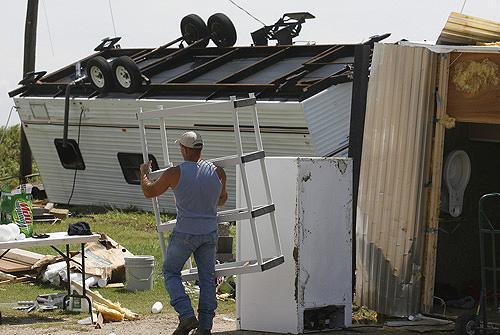Sudden hurricane rocks Gulf Coast

Kevin M. Cox The Associated Press THE ASSOCIATED PRESS, KEVIN M. COX
September 14, 2007
HIGH ISLAND, Texas – Call it the instant hurricane.
Humberto, which grew faster than any storm on record, from tropical depression to full-scale hurricane landfall, surprised the Texas-Louisiana coast early Thursday with 85-mph winds and heavy rain that knocked out power to more than 100,000 and left at least one person dead.
Meteorologists were at a loss to explain the rapid, 16-hour genesis of the first hurricane to hit the U.S. since 2005.
“Before Humberto developed, you looked at the satellite imagery the day before, and there was virtually nothing there. This really spun up out of thin air, very, very quickly,” said National Hurricane Center specialist James Franklin in Miami. “We’ve never had any tropical cyclone go from where Humberto was to where Humberto got.”
Surprising as Humberto was, forecasters said it may have been a blessing that it didn’t linger longer over warm waters of the Gulf of Mexico, which could have given it time to develop into more than a minimal hurricane.
Get The Daily Illini in your inbox!
Texas coastal residents prepared for a tropical storm rainmaker that would quickly flood the ground that was already saturated from the wettest summer in 60 years. Although forecasts called for up to a foot of rain, Humberto produced no more than half that and instead generated much more wind. By late afternoon, it had weakened to a tropical depression churning across the deep South.
“We feel very fortunate and blessed it wasn’t worse,” said Beaumont resident Edward Petty, 50, who lives 50 miles northeast of High Island, near where the storm came ashore.
“It was amazing to go to sleep to a tropical storm and wake up to a hurricane,” he said. “What are you going to do? You couldn’t get up and drive away. You couldn’t run for it. You just have to hunker down.”
The only reported death was a man who died in southeast Texas when the carport at his home collapsed, police said.
Humberto made landfall less than 50 miles from where Hurricane Rita did in 2005, and areas of southwest Louisiana not fully recovered from Rita were bracing for more misery.
“I’m in a FEMA trailer (because of Rita) and I’m on oxygen,” said Albertha Garrett, 70, who spent the night at a shelter in the Lake Charles Civic Center. “I had to come to the civic center just in case the lights would go out, because I’m alone and I’m handicapped.”
About 100,000 customers lost power in Beaumont and Port Arthur. In Louisiana, the storm flooded highways and knocked out power to about 13,000 homes and businesses.
Along Port Arthur’s refinery row, three plants were idled until power was restored. Some of the plants could be off-line for several days, even after power is restored, because they must undergo the full restart process.
Hurricane center forecasters first mentioned what would become Humberto on Saturday, when it was a disorganized system of showers and thunderstorms stretching from Cuba west over the southern Gulf of Mexico.
By 11 a.m. Wednesday, it had organized into a tropical depression with 35 mph winds and by 2 p.m. was a 45-mph tropical storm, centered just 70 miles off shore. At 1:15 a.m. Thursday, it was upgraded to an 80-mph, Category 1 hurricane, only 15 miles from the coast. Less than two hours later, at 3 a.m., its center roared ashore with 85-mph winds just east of High Island.
Only three other storms have pulled off a similar feat, growing from depression to hurricane in 18 hours – Blanche in 1969, Harvey in 1981 and Alberto in 1982 – but all of them were out at sea at the time, not close to shore like Humberto.
Experts can’t draw conclusions on possible trends of faster-forming hurricanes based on just one storm. Franklin said part of the problem was Humberto was a relatively small-sized storm, making it harder for forecasters and computer models to analyze.
Associated Press writers Matt Sedensky reported from Miami. Tony Winton in Miami and David Koenig in Dallas also contributed to this report.






